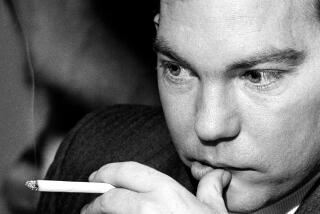Pol Pot’s Death: A Macabre Chapter Ends
- Share via
Pol Pot, a former teacher and lover of poetry who emerged from the jungles in 1975 to lead the Khmer Rouge’s campaign of terror and mayhem in Cambodia, has died what may be a fitting death--alone, betrayed by his closest allies, reviled by the world.
He is believed to have been 69 and is said to have suffered a fatal heart attack Wednesday in the northern jungles of Cambodia, though some diplomats in Southeast Asia speculated that the remnants of his once-loyal Khmer Rouge guerrillas may have murdered him because he had become such a liability to all.
However he met his end, the death of Pol Pot--the nom de guerre of Saloth Sar, the French-educated son of a prosperous Cambodian landowner--represents the final chapter of one of the 20th century’s most macabre social experiments. During his 44-month reign of terror, from 1975 to 1979, executions, torture and starvation claimed the lives of more than 1 million Cambodians.
Inspired by Josef Stalin and by Mao Tse-tung’s Cultural Revolution, Pol Pot, an ultra-orthodox Communist, adopted a philosophy best described as peasant romanticism. The peasants, he believed, were the only “pure” Cambodians, untainted by foreign influence. All others--professionals, intellectuals, city dwellers--needed to be “cleansed” and made part of a collective agrarian society.
Within months of overthrowing the U.S.-backed government of Lon Nol, Pol Pot and his boyish army of Khmer Rouge guerrillas had emptied Phnom Penh, the capital, and the other cities of inhabitants, sending millions of Cambodians into the countryside on forced marches. A nightmare of Hitler-esque proportions had begun.
Middle Class Driven Into the Fields
Money was abolished. Libraries and hospitals were smashed. Thousands of Buddhist monks were slaughtered. Tuol Sleng High School in Phnom Penh was turned into a torture and execution chamber where pubescent Khmer Rouge boys recorded biographical data of victims before killing them.
Members of the middle class--doctors, lawyers, teachers, merchants--were ordered to abandon their jobs and dispatched to forced-labor agricultural camps. Thousands were killed because they wore glasses or spoke a foreign language, a damning mark of having been corrupted by outside influences.
Starvation cursed the land, bodies turned to skeletons on the farmland where they fell, until finally the phrase “the killing fields” became synonymous with Cambodia, a country that 800 years earlier had been part of the vast, progressive Khmer Empire, reaching across Southeast Asia.
Clearly, Pol Pot did not personally oversee most of the killing. But, human rights groups say, he certainly knew about it, could have stopped it and was responsible for it, because it was carried out in the name of policies he designed.
Though few names in the world were more infamous than his, Pol Pot himself remained a shadowy, secretive figure up to his death.
When he led the Khmer Rouge to power in 1975, even well-connected Western intelligence agencies knew little about Pol Pot or his background. It was two years before observers discovered that Pol Pot and Saloth Sar, the French-educated Communist who had come home to teach and then seemed to disappear, were one and the same. Even his age remains in dispute, ranging from 69 to 73.
Pol Pot wasn’t seen for years at a time. He gave an interview to a Western journalist in 1979, was photographed in 1982, then all but disappeared until 1997. That’s when Nate Thayer, an American correspondent for the Hong Kong-based Far Eastern Economic Review, covered the jungle show trial of Pol Pot by Khmer Rouge rebels who had turned against him and held him under house arrest after sentencing him to life in prison for treason.
“The way the Khmer Rouge leaders hid themselves was simply unique in the world,” Hun Sen, Cambodia’s second prime minister (and a former Khmer Rouge), who has ruled the country since mounting a July coup, said in 1996. “It was hard for us to even meet someone holding the rank of chief of a region.”
Thayer was among those who confirmed Pol Pot’s death after viewing other journalists’ television footage from a Cambodian village about two miles from the Thai border.
The images showed Pol Pot, clad in trousers and a shirt and partly covered by a green shirt, lying dead in a simple hut. Thai authorities said Pol Pot’s present wife had discovered his death when she went to hang a mosquito net around his bed.
In the television footage, there were a few flowers on the bed above his head and a fan by his side. His hair was dark, whereas footage of him shot last year had shown a man with a shock of white hair.
But “there is no question that this is Pol Pot and that he is dead,” Thayer told the BBC.
The Khmer Rouge’s clandestine radio late Thursday read a brief statement, saying, “Our radio would like to declare that Pol Pot died of illness at 10:15 p.m. on April 15, 1998.”
While Cambodia’s government said it wanted to see Pol Pot’s body before it would confirm his death, the Khmer Rouge said he would be cremated in the next few days.
Many secrets of Pol Pot’s life went to the grave with him. It is known that he suffered from severe malaria and that his first wife, Khieu Ponnary, went insane. After she was sent to an asylum in China, he married a younger woman who bore him a daughter.
But details of his final years spent on the run in jungle hideaways remain a mystery.
Pleasant Manners and Lack of Ambition
Saloth Sar is said to have been born May 19, 1928, in the central Cambodian province of Kompong Thom, to a wealthy family. Like many Cambodians, Sar spent time as a monk. His brother held a minor administrative post in the royal palace, and his aunt was a leading dancer in the Cambodian Royal Ballet. Sar attended high school in Phnom Penh where, his biographer, David P. Chandler, writes, he was remembered for his pleasant manners, love of sports and lack of ambition.
In August 1949, he and 20 other bright young Cambodians--having received scholarships from the French colonial administration in Phnom Penh--set off on the French ship Jamaique to study in Paris. Sar did not appear to have any particular ideology or attraction to radical political doctrines.
But Paris in those days was a hotbed of left-wing debate and growing Communist influence. Stalinism had not yet been discredited. And Sar got caught up in the revolutionary spirit, so much so that he often neglected his studies in radio electronics.
He and other young Cambodians began dreaming of liberating their country’s peasants from the exploitation of French colonialism, the favored urban elite and the Cambodian royalty, led by Prince Norodom Sihanouk.
Sar returned to Phnom Penh in 1953 and took a job as a teacher in a private school. He loved French classics, could recite passages from Verlaine, his favorite poet, by heart and was remembered by his students as a gentle, soft-spoken and charming man.
What few people knew was that he was already plotting the overthrow of Cambodia’s feudal system.
In 1963, Sar fled into the jungles and became Pol Pot. There, he set up his Communist army. Twelve years later, on April 17, 1975--13 days before North Vietnam’s Communist army marched into Saigon--Phnom Penh fell to the Khmer Rouge.
Pol Pot adopted a new calendar and declared 1975 as “Year Zero.”
Although he referred to himself as “Brother No. 1,” Pol Pot, unlike many dictators, never built a personality cult around himself. And even when it became apparent that terrible things were happening in Cambodia, the Khmer Rouge had its global supporters, some of them Westerners smitten with Pol Pot’s boyish army and its seemingly gallant mission of back-to-the-land redemption. Mao Tse-tung went so far as to compliment the Khmer Rouge leader’s revolutionary ardor when Pol Pot visited Beijing, saying, “You have achieved in one stroke what we failed to do with all our masses.”
‘I Have Seen the Past, and It Works’
Malcolm Caldwell, a Scottish Marxist economist who interviewed Pol Pot in 1979, the only Westerner to do so before Thayer, said shortly before being murdered in Cambodia, “I have seen the past, and it works.”
Generally, it was believed that Pol Pot’s xenophobic, mindless cadre of reformers were responsible for the deaths of one of every seven Cambodians. Researchers at Yale University’s Cambodian Genocide Program said the number may actually be substantially higher. By 1996, they had located more than 100 “killing fields” with 8,140 pits for mass graves. They said Cambodia might contain 12,000 more such pits.
Joe Swain, a journalist with the Sunday Times of London, interviewed two of Pol Pot’s brothers a few years ago. Neither had seen Pol Pot in more than 30 years. One brother, Saloth Seng, told of seeing his son murdered by the Khmer Rouge in 1976 with a blow to the skull from a farm tool.
“I wish my brother lived outside this world,” he said. “I am disappointed with him. If he ever comes back to his native village, every living Khmer should be invited to cut him with a razor blade.”
The second brother, Saloth Nhep, added: “I shall never fully understand what went on in my brother’s head. Everyone here agrees that as a child he was a lovely boy, very gentle.”
In the late 1970s, Pol Pot turned against his former allies in Vietnam and began conducting inexplicable cross-border raids. Vietnam responded by invading Cambodia, and, in 1979, once again, Pol Pot fled into the jungle.
It could have been the end of the Khmer Rouge had not China and Thailand helped to rebuild the movement in hopes it could force Vietnam’s withdrawal from Cambodia. The U.S. government supported the Khmer Rouge’s successful claim to Cambodia’s U.N. seat against that of the Vietnamese-backed regime in Phnom Penh.
China forced the Khmer Rouge to sign the Paris peace agreement of 1991 (Pol Pot did not attend the signing) that reinstalled the monarchy under Prince Sihanouk and created a shaky coalition between the royalists, headed by Prince Norodom Ranariddh, and the former Communists, led by Hun Sen. The Khmer Rouge pulled out of the peace process in 1993.
Although both factions courted the Khmer Rouge as a counterweight to their opposition, the guerrilla movement was clearly in the process of imploding in the period leading up to Pol Pot’s death. It was torn by deadly internal rivalries, isolated in jungle encampments and so discredited throughout the world that even China was reported to have rejected Pol Pot’s request for asylum.
In mid-June 1997, Pol Pot, living in Anlong Veng, near the Thai border, ordered the killing of Son Sen, 67, the Khmer Rouge’s former defense minister, and his powerful wife, Yun Yat, 63.
That turned even the remnants of the Khmer Rouge army against him, and he is said to have fled deeper into the jungle, racked by malaria and carried on a stretcher by his remaining band of loyalists. He was pursued by a force of 1,000 of his former boy-soldiers.
Although the Vietnamese conducted a “trial” in 1979 that found Pol Pot guilty of genocide, the onetime schoolteacher never did answer for his crimes in an international tribunal and apparently remained unrepentant to the end.
But clearly in the court of world opinion he was judged long ago as a man whose very name conjured up images of the worst kind of atrocities.
* POL POT REMEMBERED: Death revives pain in Long Beach’s Little Cambodia. B1
* CAMBODIAN’S SLAYING: Three gang members convicted of killing actor Haing Ngor. B1
* MIKE DOWNEY: Double justice for a victim of the ‘killing fields.’ A3
(BEGIN TEXT OF INFOBOX / INFOGRAPHIC)
Cambodian Tyrant
It was 23 years ago today that the Khmer Rouge, led by Pol Pot, marched into the capital of Cambodia and began an experiment in agrarian communism that led to more than 1 million deaths.
(BEGIN TEXT OF INFOBOX / INFOGRAPHIC)
A Haunting Legacy
POL POT’S BIOGRAPHY
May 19, 1928: Reported date of birth--as Saloth Sar--in Cambodia’s Kompong Thom province.
1940’s: Joins the anti-French resistance under Ho Chi Minh.
1946: Joins the Communist Party.
August 1949: Goes to Paris to study radio electronics.
January 1953: Returns to Phnom Penh, the capital.
1954-1963: Teaches at a private school in Phnom Pehn.
April 17, 1975: His Khmer Rouge guerrilla force overthrows government. Disastrous experiment in agrarian communism--featuring labor camps--begins.
1975-1979: More than 1 million people die under Khmer Rouge rule, from forced labor, starvation, torture or execution.
1979: Vietnam invades Cambodia, driving Khmer Rouge to western frontier with Thailand.
August 1979: Sentenced to death in absentia by special tribunal for “genocidal crimes.”
1985: Officially removed from military and political leadership of the Khmer Rouge
August 1992: Khmer Rouge reports that he has retired.
June 1997: Surrenders to defectors from Khmer Rouge.
July 1997: Sentenced to life imprisonment by Khmer Rouge opponents. American reporter Nate Thayer, the first western journalist to see Pol Pot in 18 years, reports him to be seriously ill and unable to walk without help.
April 15, 1998: Pol Pot dies in jungle hideaway in Anlong Veng.
Compiled by ROBIN MAYPER, PAUL SINGLETON and SCOTT J. WILSON / Los Angeles Times
****
VOICES
“Although Pol Pot was the most notorious leader, the Khmer Rouge regime had a collective leadership. These senior leaders fully share responsibility for what occurred, and those responsible for crimes of that kind should be prosecuted.”
--State Department spokesman James P. Rubin
*
“Our movement made mistakes. I came to carry out the struggle, not to kill people. Even now, and you can look at me: Am I a savage person? My conscience is clear.”
--Pol Pot to American journalist Nate Thayer
*
“I’m disappointed because I wanted him to suffer. . . . His spirit may suffer in hell, but I wanted to see him physically suffer. . . . I wanted him to learn that how we suffered, that is the same way he should have suffered.”
--Dith Pran, New York Times photographer whose suffering and escape from the Khmer Rouge was subject of the Oscar-winning movie ‘The Killing Fields.’
*
“I am only sorry that he died so easily without being tried. I wanted to see international organizations try him for his pitiless acts of killing his own people.”
--Kim Saren, whose mother, father, five brothers and four sisters were murdered by the Khmer Rouge.
More to Read
Sign up for Essential California
The most important California stories and recommendations in your inbox every morning.
You may occasionally receive promotional content from the Los Angeles Times.










